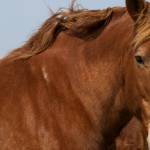Cresty Necks in Horses: Possible Physical Sign of Metabolic Issue

A hallmark of certain metabolic conditions such as insulin resistance and metabolic syndrome is a cresty neck—sometimes in combination with obesity, sometimes not.
Researchers assign a cresty neck score (CNS) to describe degree of fat deposition and to monitor changes in neck thickness. A narrow range of scores exists; a score of 0 would describe a neck with no crest, and a score of 5 would describe a massive crest that has shifted permanently to one side, called a fallen crest. Researchers have established a correlation between insulin resistance and horses with cresty neck scores of 3 and above.
Draft horses and draft crosses, some pony breeds, and Morgan horses may naturally display a bit more crestiness than members of other breeds. Additionally, stallions of any breed might retain more crest than mares or geldings because deposition of fat in the neck is a secondary sexual characteristic. These natural conformational attributes in a horse of moderate body condition should not be mistaken for a definitive signal that a metabolic condition exists.
A working knowledge of CNS is probably not as essential for horse owners as a thorough understanding of body condition score (BSC). However, in managing horses prone to metabolic conditions, it can be a useful tool in assessing disease progression.








